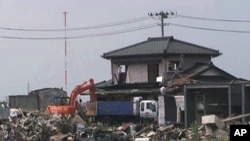It's nearly five months since the huge tsunami struck northeast Japan, killing over 20,000 people. The reconstruction effort is well under way and the government has earmarked several billion dollars to help survivors rebuild their homes and livelihoods. Many survivors say the financial assistance has been too slow.
Much left to be done in Sendai
On board one of the first scheduled flights into Sendai since the earthquake. The approach reveals a shoreline still bearing the scars of the tsunami.
Flattened pine woods and flooded rice fields are littered with piles and piles of wreckage. But progress is being made.
The airport has reopened less than five months after the wave hit - a physical and psychological link to the world.
In the Sendai suburb of Okada, just a couple of kilometers from the shore, Takahashi Masao is digging the garden outside his home - which somehow stayed standing.
He remembers hearing the tsunami warning siren on March 11 - and running up to the second floor balcony.
“When the earthquake struck I was wondering what would happen, how big the tsunami might be,” he says. “I was watching and watching. And then the wave came over those pine trees. ‘This is big,’ I thought,'” says Takahashi. “I realized it would soon reach my car parked down there. But there was nothing I could do. So I came up to the second floor and watched it all from here.”
Much of the ground floor was gutted. Takahashi is slowly rebuilding, starting with the family shrine. There is much more expensive work to be done.
“Everyone says the money has been really slow,” he says. “Only 30 percent of people affected in Sendai have received money. The government says this is a really massive disaster so people should understand it’s slow, but it’s very frustrating. If the government would say that here is not a good place to live, that you can’t live here, I wouldn’t fix this house, I would leave. But the traffic signals are being fixed just over there. So it seems like we can still live here. Noone knows.”
Reconstruction under way
Outside, engineers are also fixing the cell phone network. The water, gas and electricity have already been reconnected. The total cost of post-tsunami reconstruction is estimated to be near $300 billion.
The ancient Hama Kaido coast road used to be a summer escape route from Sendai city. Now it is choked with trucks carrying wreckage.
With typical Japanese efficiency it is sorted into neat piles. Local authorities have set a recycling target of 50 percent.
The rest will be buried or burned in one of the three incinerators being built on former seaside parkland.
Mixed expectations for the future
In Miyagi Prefecture alone, authorities estimate they will collect around 18 million metric tons of debris.
In the shadow of the garbage dumps, Maeda Hiroko picks the weeds from her vegetable patch. She fears little will grow here because of the saltwater.
“The government says people should move out from the whole area,” says Maeda. “But we have our house and land here. I believe everyone who still has something here, whose houses are at least still standing, will come back.”
Such optimism is reflected across Japanese society - helping to drive the reconstruction effort. Privately, many of the survivors still fear an uncertain future.












